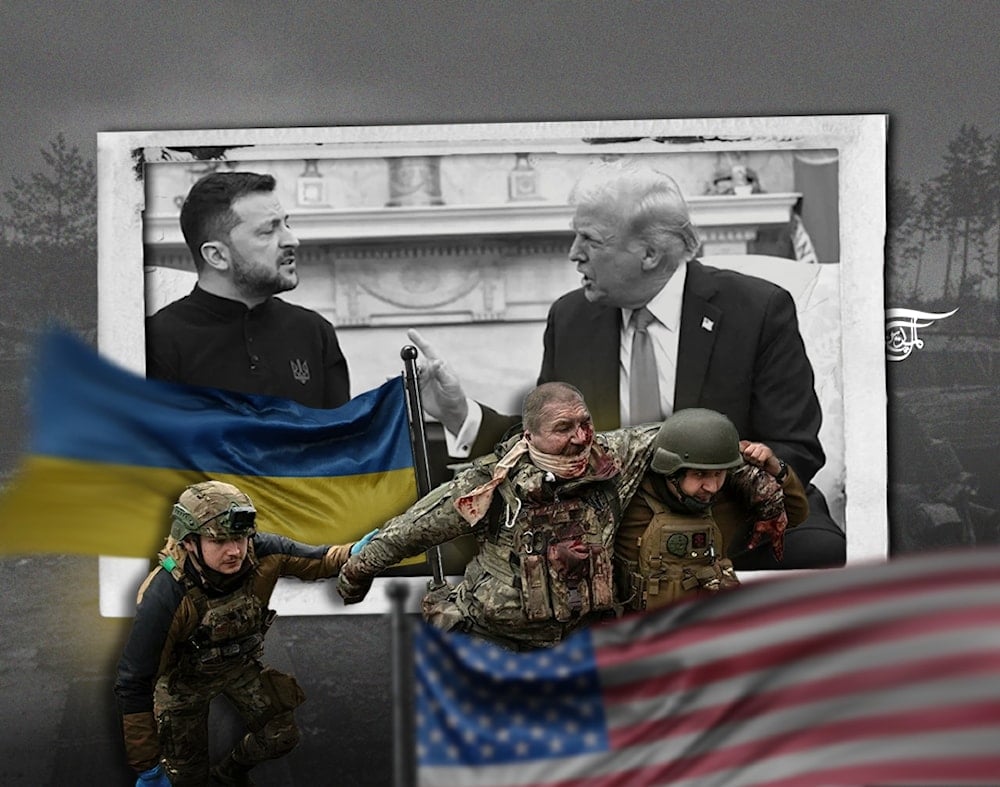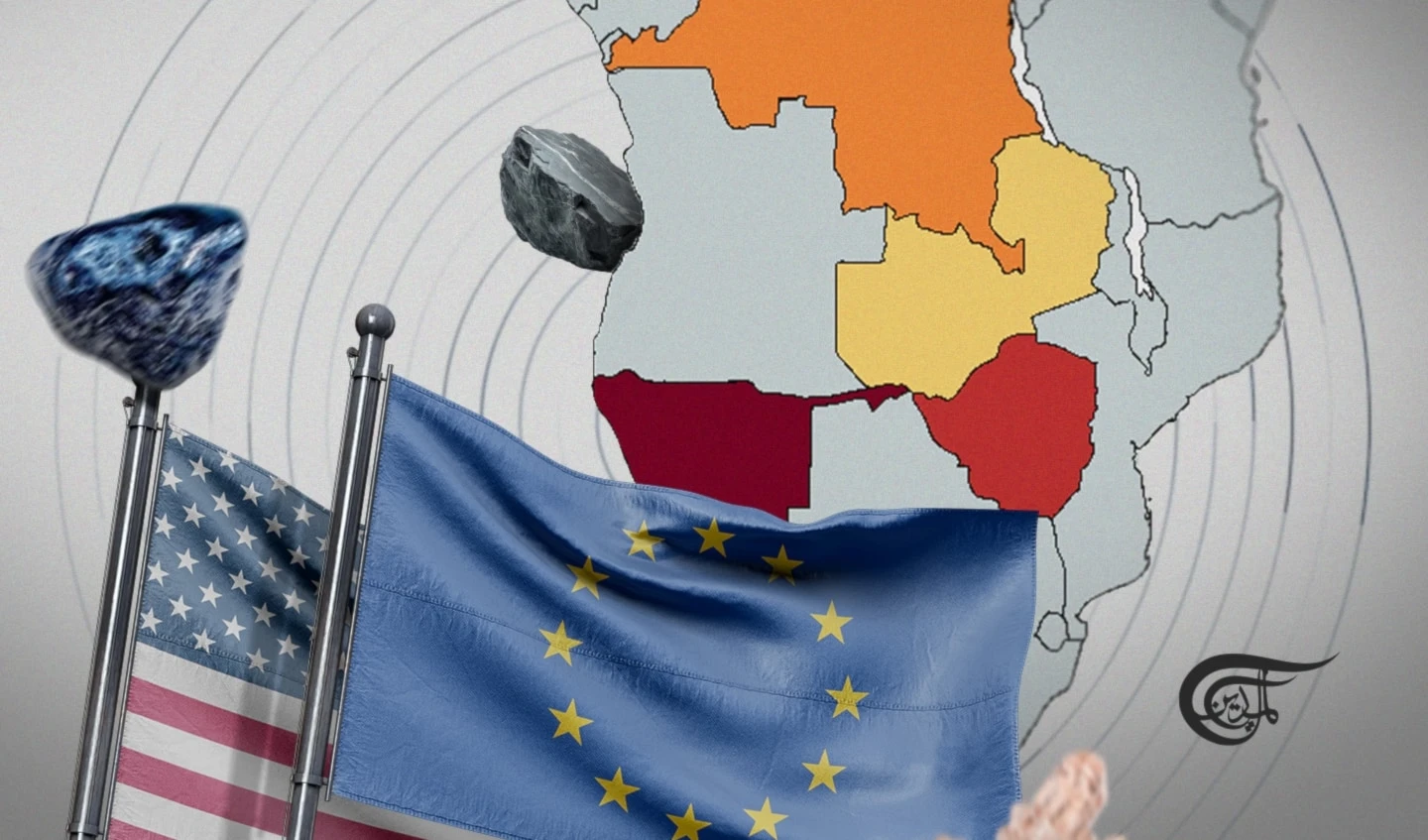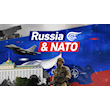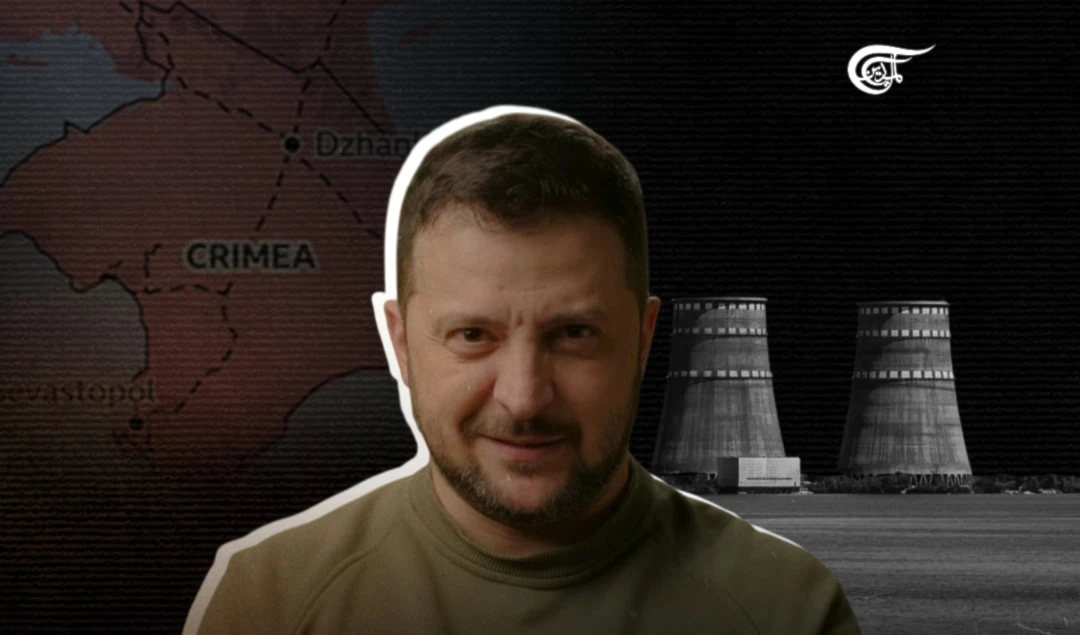An elusive ceasefire in Ukraine as Kiev and its Western backers play for time
Dmitri Kovalevich examines how Zelensky’s administration, backed by Western powers, is prolonging Ukraine’s war with Russia through martial law, forced conscription, and failed diplomacy, risking internal collapse to maintain power.
-

The government in Kiev is an institution at the service of the Western powers. Since 2014, it has obliterated Ukraine's sovereignty in a destructive path aiming to become the West’s ‘anti-Russia’. (Al Mayadeen English; Illustrated by Zeinab El-Hajj)
As April 2025 draws to a close, Ukrainian society is expecting a truce of some kind to be reached with Russia, permitting an end to forced military conscription and deadly battlefield hostilities. But Ukrainian President Volodomyr Zelensky decided on April 19 to extend martial law for three more months, until August 6, 2025, even though the current martial law does not expire until May 29.
The obedient legislature of Ukraine (‘Verkhovna Rada’) has extended martial law every three months since February 2022 at the request of Zelensky’s office. Martial law brought the closing of Ukraine’s national borders (except by special permission to cross), cancelation of national elections for president and the Rada that were supposed to take place one year ago according to the Ukraine constitution, and the continued snatching of military recruits from the streets of towns and villages across what remains of the battered country.
The rush to extend martial law is seen in Ukraine as evidence of the administration’s fear that peace concessions to Russia could cause a ‘revolt’ of the many far-right legislators in the Rada and their related paramilitaries. Overall, peace would weaken or outright end the rule of Zelensky because his administration depends on warfare for its continued rule.
The Ukrainian Telegram channel ‘Resident’ writes that the vote to extend martial law is an effort by Andriy Yermak, the head of the presidential office of Zelensky, to keep Ukrainian elites under control. Kiev is promising that new military supply agreements are forthcoming with Britain and the countries of the European Union, but oligarchs in Ukraine are believing his words less and less because the government is obviously losing control over the political and military situation. Yermak’s office now fears a ‘Fronde’ more than it fears the Trump Administration, writes Resident, “because its control over its security forces is only an illusion”. (The ‘Fronde’ was a series of civil wars in the Kingdom of France between 1648 and 1653, occurring in the midst of the Franco-Spanish War, which began in 1635.)
Ukrainian Political Analyst Kost Bondarenko believes that Zelensky's latest decision to extend martial law is a showy gesture to Trump. “The rushed vote for the extension of martial law, nearly three weeks prior to the expiration of the existing term, was needed in order for Zelensky to send a figurative gesture to Trump. This is how my interlocutors in the USA assess this step.”
Former Rada legislator and political analyst Oleg Tsaryov noted on Telegram on April 16, “Zelensky rushed to extend martial law in order to eliminate even the slightest risk that Trump would be able to achieve a truce that would turn into peace talks and end the war before Easter Friday, April 20.”
According to Tsaryov, “The chances of Trump realizing this scenario were extremely low, but Zelensky decided to assure himself and eliminate even this hypothetical threat to himself.”
The analyst makes the bold assumption that Trump actually desires peace in Ukraine, as opposed to managing a looming defeat of the Western military alliance. By all current evidence, the war will continue, as will the tragic human losses. Oleksandr Dubinsky, an elected member of the Rada who is being held in a Kiev detention center on suspicion of state treason, emphasized in a brief note on Telegram on April 16 that “another extension of the power of Zelensky and his gang of kleptocrats has a definite price”. According to him, that price will be “another 30,000 dead Ukrainians by August 6”.
Condemnations of China by Kiev
Also in April, Zelensky launched another sharp condemnation of the Chinese government, which for the past three years has offered suggestions for a peaceful settlement while maintaining diplomatic relations with all sides. On April 17, Zelensky accused the government of China of directly supplying weapons to Russia, particularly in the form of gunpowder and artillery shells.
As reported by Politnavigator on its Telegram channel on April 17, Zelensky said President Xi Jinping had promised to him some time ago that arms manufacturers in China would not sell or provide weapons to Russia. “He gave me his word that he would not sell or give weapons to Russia, but now, unfortunately, we are seeing different information,” Zelensky recently stated in a raised tone.
On April 18, Zelensky imposed sanctions against three Chinese aircraft manufacturing companies, although none of the three have any present or past dealings with Ukraine’s all-but grounded aerospace industry.
Zelensky's political survival
Zelensky's outbursts against both the US and China add to what he already routinely delivers against Russia. They demonstrate the rather desperate political standing of his government. His desire to prolong the US/NATO proxy war is a matter of political survival for him and his administration.
Vadym Prystayko, former deputy head of the Ukrainian presidential administration and former foreign minister, wrote on Telegram on April 16 that other countries, especially in the Global South, are fed up with the Ukrainian issue because Kiev and the West persistently ignore problems and conflicts in other regions. Prystayko recalls in his message a conversation with a certain ambassador from a friendly Arab country. “He told me, ‘You know, I am sick of you and all your talk about Ukraine. You don't notice the tragedies that are happening all around the world, and I'll tell you why. Because this is a war by white people’.”
As a matter of fact, Kiev has promoted the idea since 2014 that the only ‘true’ Ukrainians are ‘white and civilized’ people of European origin. Their historic mission, according to this racist doctrine, is to oppose the ‘Asian hordes’ of the East. A similarly abhorrent doctrine prevailed in Great Britain and France during the colonial era as their respective empires seized territories belonging to other peoples and worked to ensure that being tied to their ‘civilized’ countries would benefit one subjugated people over another in a neighboring country lacking such ties.
The Ukrainian Institute of Politics wrote on April 16 that the Ukrainian government's strategy is based on two key assumptions: ‘Putin will someday be gone, and Trump is a temporary phenomenon’. “The government in Ukraine is counting on a change in political conditions and a more favorable foreign policy configuration sooner rather than later. Until then, the course remains the same: ‘Wait out the turbulence’.”
Pretend mediation by the US for peace
Against this background, the US government is claiming it may withdraw from its involvement in the Ukrainian conflict if a peace agreement on its terms is not reached. US Secretary of State Marco Rubio said on April 18 that the US would stop trying to mediate a peace agreement between Russia and Ukraine in a few days if there were no clear signs that a deal could be reached. But 10 days later, pretend mediation efforts continue, with the Trump administration saying on April 25 that Russia must accept a continued place for Ukraine’s armed forces in the country. This contradicts one of the key objectives of Russia in the military conflict, which is a ‘demilitarization’ of Ukraine. There is not a hint coming from Moscow of a compromise on this stance.
Russian diplomat Mikhail Demurin believes that the US is simply trying to move out of the line of fire (and accountability) over Ukraine in order not to be associated with the losing side. “Western European allies of Zelensky's regime will suffer significant losses from his fall, though they may not be critical losses. They still have a lot of resources and means at their disposal. The Americans, however, are creating conditions for themselves to ‘crawl away’ from the conflict in Ukraine, leaving it to NATO allies to pick up the pieces while the US focuses on its escalating trade war with China.”
Demurin warns, “As before, there will be continued pressure against Russia in trade, finance, and military-political spheres. Hostile actions will continue, primarily though not limited to the Baltic Sea region and Transcaucasia.”
Under these conditions, the continued financing of Kiev will increasingly fall on the imperialist, NATO powers in Europe, primarily Great Britain, Germany, and France. All three continue to profess great determination to defeat Russia, even if their words are louder than what their military resources and actions could permit.
Weakened and blustering Western militaries
Germany’s state-run Deutsche Welle news service is reporting on April 16 that “In Ukraine, children are being trained for war in military-style boot camps where they learn to fire weapons, engage in close combat and carry out evacuation drills. The aim is to prepare them for the possibility that the war with Russia could continue for years.”
The Bild daily in Germany is meanwhile glorifying German mercenaries who are training to fight in the ranks of the neo-Nazi Azov regiment to “protect Europe from Russia.”
The head of German arms-manufacturer Rheinmetall, Armin Papperger, said in April that his company would construct an ammunition plant in Ukraine, although not before 2026. According to him, the plant was initially planned to produce 150,000 shells per year, but plans now call for the production volume to be significantly increased.
Such news as above being reported in Western media underline how Western military interests are aiming for a prolonged war against Russia. Conveniently, this will considerably boost the profits of many companies.
But US and European weapons manufacturers face huge problems in their warmaking ambitions. One problem is their inability to produce enough weapons; the second problem is the poor quality of what does get manufactured. The German magazine Der Spiegel reported in April that the war in Ukraine has shown German weapons to be “only partially usable”. Its source is an internal report of the German armed forces (Bundeswehr). Der Spiegel explains, for example, that Germany's ‘Panzerhaubitze 2000’ artillery units have shown such technical vulnerability in Ukraine as to place in doubt their suitability.
German Leopard 1A5 tanks, meanwhile, are only used as artillery by Ukraine’s army because their armor and their off-road mobility are inferior. Repairs to the newer Leopard tank versions (the ‘2A8’) are so expensive that they cannot be carried out at the front.
Germany’s IRIS-T short-range air defense missile system has proven very effective for the Ukrainian army, but the cost of ammunition is exorbitant. Meanwhile, the famous Patriot air defense missile system of the United States has proven altogether “unfit for military use”, according to Der Spiegel. The publication reports that the vehicles used by the Patriot system are obsolete, and spare parts for the whole system are in short supply.
In general, according to the German journalists, “hardly any large, German piece of military equipment is fully suitable for war in today’s conditions”.
Bodies are cheaper than military hardware
With losses of expensive military hardware piling up, the only remaining ‘cheap’ military resources for Ukraine are increasingly those in human form. Although losses on both sides of the US/NATO proxy are classified, regular exchanges of bodies of killed servicemen hint at the numbers and ratios of deaths and injuries on each side. In early April, Russia transferred the bodies of 909 deceased soldiers to Ukraine while receiving 43 in return.
According to data from previous months on military deaths and injuries, the number of dead on the Ukrainian side is growing, while on the Russian side, it remains approximately the same. The Strana media outlet reported on Telegram on April 18 that the number of dead Ukrainian soldiers being sent home during exchanges with Russia has increased sharply in recent months, while Russian numbers are much smaller and even decreasing.
On Saturday, April 19, the two sides conducted the largest exchange to date of prisoners of war, with 277 Ukrainian soldiers and 246 Russian ones headed home.
Ukrainian legislator Anna Skorokhod told an interviewer on April 17 that many of the military recruits who were “grabbed on the street” by military conscription brigades are not motivated and not ready for combat. “If a person is opposed morally to fighting or cannot do so physically, no matter how much you force him, he is not a fighter. We do have lots of officers in our armed forces, but officers do not fight. The number of those with real combat experience is actually small,” she says, noting that such small numbers suggest that recruits don’t live long enough to become experienced.
For the same reason, says Oleg Starikov, a Ukrainian military expert and reserve colonel in the SBU (Security Service of Ukraine), the strategic initiative is now on Russia's side. “The enemy has a lot more people, and it now has the advantage, the strategic initiative. They are imposing upon us where they will attack; we are locked into in strategic defense.”
Anatoliy Kinakh, former prime minister of Ukraine and current head of the Ukrainian Union of Industrialists and Entrepreneurs, claims that in a recent conversation with representatives of the AFU General Staff who are responsible for the moral and psychological state of the troops, he was told that soldiers have stopped believing that they are defending “a just state”. This is particularly acute at the front, Kinakh said.
None of the soldiers being discussed have had any say in the war being waged. Modern police methods and violence are used to hunt down recruits and send them to the slaughter.
Ukraine is serving as a certain testing ground for the Western powers and for authoritarian regimes such as Zelensky's. In the future, coercive methods of military recruitment will ‘come home’ and be used by Western governments against the very people they govern when it comes their turn to don uniforms and fight to uphold the hegemony of Western imperialism. Ironically, coercive practices will even come to be used against the pseudo-leftists in the West who have been providing cover for the far-right government in Kiev by supporting its war effort and describing it as an institution of Ukraine ‘sovereignty’. The world’s peoples are paying dearly for such misguided ignorance. The government in Kiev is an institution at the service of the Western powers. Since 2014, it has obliterated Ukraine's sovereignty in a destructive path aiming to become the West’s ‘anti-Russia’.

 Dmitri Kovalevich
Dmitri Kovalevich
 14 Min Read
14 Min Read












